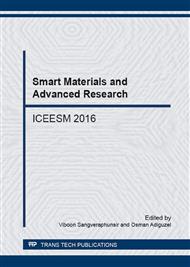[1]
A. Ruggiero, et al., Friction and wear behaviors of Al/Epoxy Composites during Reciprocating Sliding tests, Manufacturing Technology. 15 (2015) 684-689.
DOI: 10.21062/ujep/x.2015/a/1213-2489/mt/15/4/684
Google Scholar
[2]
M. Müller, P. Valášek, Assessment of bonding quality for several commercially available adhesives, Agronomy Research. 11 (2013) 155-162.
Google Scholar
[3]
P. Valášek, M. Müller. Polymeric composite based on glass powder - Usage possibilities in agrocomplex, Scientia Agriculturae Bohemica. 2 (2013) 107-112.
DOI: 10.7160/sab.2013.440207
Google Scholar
[3]
P. Valášek, M. Müller, Composite based on hard-cast irons utilized on functional parts of tools in agrocomplex, Scientia Agriculturae Bohemica. 3 (2013) 172-177.
DOI: 10.7160/sab.2013.440308
Google Scholar
[4]
A.J. Kinloch, Toughening structural adhesives via nano-and micro-phase inclusions, Journal of Adhesion. 79 (2003) 867-873.
DOI: 10.1080/00218460309551
Google Scholar
[5]
R. Kilik, R. Davies, Mechanical properties of adhesive filled with metal powders, International Journal of Adhesion and Adhesives. 9 (1989) 224-228.
DOI: 10.1016/0143-7496(89)90065-1
Google Scholar
[6]
F.N. Ahmad, et al., Effect of particle shape of silica mineral on the properties of epoxy composites, Composites Science and Technology. 68 (2008) 346-353.
DOI: 10.1016/j.compscitech.2007.07.015
Google Scholar
[7]
J.J. Chang, W.C. Yeih, The effects of particle shape on bond strength improvement of epoxy-particle coating composites, Journal of Marine Science and Technology. 9 (2001) 153-160.
DOI: 10.51400/2709-6998.2446
Google Scholar
[8]
P. Jojibabu, et al., Effect of different carbon nano-fillers on rheological properties and lap shear strength of epoxy adhesive joints, Composites Part A: Applied Science and Manufacturing. 82 (2016) 53-64.
DOI: 10.1016/j.compositesa.2015.12.003
Google Scholar
[9]
L.L. Zhai, et al., Effect of nano-Al2O3 on adhesion strength of epoxy adhesive and steel, International Journal of Adhesion and Adhesives. 28 (2008) 23-28.
DOI: 10.1016/j.ijadhadh.2007.03.005
Google Scholar
[10]
P. Valášek, Influence of surface treatment of steel adherends on shear strength of filled resins, Manufacturing Technology. 15 (2015) 468-474.
DOI: 10.21062/ujep/x.2015/a/1213-2489/mt/15/3/468
Google Scholar
[11]
H.A. Al-Turaif, Effect of TiO2 surface treatment on the mechanical properties of cured epoxy, Journal of Coatings Technology Research. 8 (2011) 727-733.
DOI: 10.1007/s11998-011-9351-0
Google Scholar
[12]
R. Kahramana, et al., Influence of adhesive thickness and filler content on the mechanical performance of aluminum single-lap joints bonded with aluminum powder filled epoxy adhesive, Materials Science Forum. 205 (2008) 183-189.
DOI: 10.1016/j.jmatprotec.2007.11.121
Google Scholar


